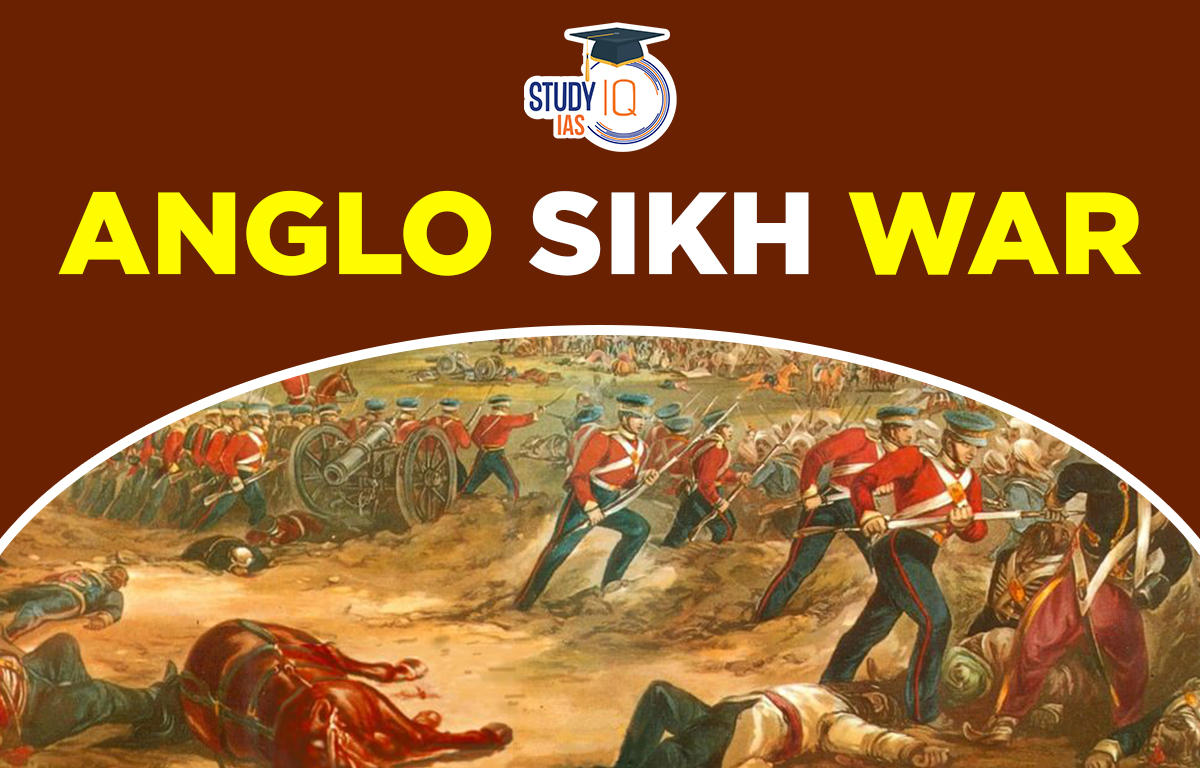Table of Contents
Anglo-Sikh War
Read all about Anglo-Sikh Wars. The British started fighting Sikh troops because they were closely observing the events in Punjab and had their sights set on the lush plains on the opposite side of the Sutlej. Anglo-Sikh ties deteriorated after Major Broad was appointed Company’s Agent in 1843 at Ludhiana for Sikhs.
The Sikh troops who crossed the Sutlej in December 1845 and assumed an offensive stance against the English army were disturbed by the British actions and preparations. Battles were subsequently fought at Mudki, Ferozeshah, and Aliwal. The first Anglo-Sikh War was resolved with the crucial battle of Sobraon, which took place on February 10, 1848. You will learn about the Anglo-Sikh War in this article, which will help you with your preparation for the UPSC Civil Service Exam in modern Indian history.
Read about: Battle of Buxar
First Anglo Sikh War
The Sikh Empire and the British East India Company engaged in combat there and elsewhere in the First Anglo-Sikh War in 1845 and 1846. The Sikh empire lost ground and partially submitted, and Jammu and Kashmir was ceded as a distinct princely state subject to British suzerainty.
1. First Anglo Sikh War (1845-46) History
Early in the nineteenth century, Maharaja Ranjit Singh expanded and solidified the Sikh kingdom of Punjab as British-controlled territories moved through conquest or annexation toward Punjab’s borders. In order to prevent British expansion and to wage war against the Afghans, Ranjit Singh maintained a cautious alliance with the British, ceding some territories south of the Sutlej River.
In addition to including Hindu and Muslim contingents, he employed American and European mercenary warriors to train his army. The English were justified in starting a war because of this perceived aggression. The causes, however, were much more complex and can be summed up as follows:
- Maharaja Ranjit Singh’s death caused disorder in the Lahore monarchy, which led to a fight for supremacy between the Lahore court and the steadily growing local army.
- Doubts among the Sikh army as a result of English military operations to capture Gwalior and Sindh in 1841 and the Afghan campaign in 1842.
- An increase in the number of English soldiers stationed close to the kingdom of Lahore’s frontier.
2. First Anglo Sikh War Courses
The British side had between 20,000 and 30,000 soldiers at the beginning of the battle in December 1845, but the Sikhs, under the command of Lal Singh, had roughly 50,000 soldiers. However, due to the betrayal of Lal Singh and Teja Singh, the Sikhs suffered a series of defeats at Mudki (December 18, 1845), Ferozeshah (December 21–22, 1845), Buddelwal, Aliwal (January 28, 1846), and Sobraon (February 10, 1846).
Without a fight, Lahore surrendered to British forces on February 20, 1846. The war’s resolution, the Treaty of Lahore On March 8, 1846, the First Anglo-Sikh War came to an end, and the Sikhs were compelled to accept a humiliating peace. The English were expected to gain more substantial war benefits.
The war’s resolution, the Treaty of Lahore On March 8, 1846, the First Anglo-Sikh War came to an end, and the Sikhs were compelled to accept a humiliating peace. The English were to receive a war indemnity payment of more than one crore rupees. To annex the Jalandhar Doab was the Company’s goal (located between the Beas and the Sutlej). In Lahore, Henry Lawrence intended to open a British residence. The strength of the Sikh army was reduced.
Lal Singh was the wazir, Rani Jindan was the regent, and Daleep Singh was recognised as the king. Because the Sikhs were unable to cover the entire war indemnity, Gulab Singh was compelled to pay the Company 75 lakh rupees as the purchase price, and Kashmir, including Jammu, was sold to him. A second contract that was signed on March 16, 1846 made it possible for Gulab Singh to receive Kashmir officially.
Because they were dissatisfied with how the Treaty of Lahore handled the Kashmir issue, the Sikhs rebelled against it. In December 1846, the Treaty of Bhairowal was ratified. Following Rani Jindan’s ouster as regent, a council of regency for Punjab was established in accordance with the terms of the treaty. The council was composed of eight Sikh sardars and was presided over by Henry Lawrence, the English Resident.
3. First Anglo Sikh War Impact
Lahore Treaty (March 8, 1846) the first Anglo-Sikh War ended on March 8, 1846, and the Sikhs were forced to accept a demeaning peace. The Sikh army’s power was reduced. Lal Singh was appointed wazir, Rani Jindan served as regent, and Daleep Singh was proclaimed ruler. Kashmir, including Jammu, was sold to Gulab Singh since the Sikhs were unable to pay the full war indemnity.
Gulab Singh was required to give the Company 75 lakh rupees as a down payment. A second treaty officially ceded Kashmir to Gulab Singh on March 16, 1846.
The Bhairowal Treaty -Because of their disagreement with the Treaty of Lahore’s resolution of the Kashmir issue, the Sikhs rose up in protest. In December 1846, the Treaty of Bhairowal was signed. As a result of the provisions of the treaty, Rani Jindan was removed as regent and a council of regency for Punjab was constituted. Henry Lawrence, the English Resident, presided over the council, which included eight Sikh sardars.
4. Anglo Sikh War Treaty
The First Anglo-Sikh War came to an end on March 9, 1846, with the signing of the Treaty of Lahore. The Treaty, which covered the forts and territory in the Jalandhar Doab between the Sutlej and Beas rivers, was signed by Maharaja Duleep Singh Bahadur and seven members of the Hazara community for the Sikhs and by Governor-General Sir Henry Hardinge and two East India Company officers for the British.
Maharaja Duleep Singh of Punjab was to remain in charge while his mother Jindan Kaur served as regent. The Doab of Jalandhar had to be turned over to the British by the Sikhs. Additionally, the Sikhs were required to pay an enormous war indemnity to the English.
The remaining was given to the English in the shape of Kashmir, Hazarah, and the areas between the Beas and the Indus Rivers because they were only able to pay a portion of the total amount due. The Sikhs were instructed to maintain a specified level of force. A British resident named Sir Henry Lawrence was also appointed to the Sikh court.
Read about: Carnatic War
Anglo Sikh War and Maharaja Ranjit Singh
He was born in Pakistani Punjab around 1780 to the Sukerchakia misl of the Sikh confederacies chief. He united 12 Sikh misls in 1801 and sacked a number of petty kingdoms to establish himself as the “Maharaja of Punjab.” Numerous Afghan raids were successfully thwarted, leading to the conquest of cities like Lahore, Peshawar, and Multan. His title is “Sher-i-Punjab” (Lion of Punjab).
His capital was Lahore after he took it in 1799. In the northwest, his Sikh Empire extended south of the Himalayas and north of the Sutlej River. His dominion included the cities of Lahore, Multan, Srinagar (Kashmir), Attock, Peshawar, Rawalpindi, Jammu, Sialkot, Amritsar, and Kangra. He kept friendly ties with the British.
His army had soldiers of various racial and religious backgrounds. In terms of fighting, logistics, and infrastructure, his army was quite effective. After his passing in 1839, there was a struggle for control among his various relatives. This marked the start of the Empire’s decline. His eldest legitimate son, Kharak Singh, succeeded him.
Read about: Anglo-Mysore War
Second Anglo Sikh War (1848-49)
The Sikh Empire and the British East India Company engaged in combat in the Second Anglo-Sikh War in 1848 and 1849. The Sikh Empire’s demise and the East India Company’s annexation of the Punjab and what would become the North-West Frontier Province marked its conclusion.
1. Second Anglo Sikh War History
Neither the English imperialist goals nor the Sikhs were served by the settlement of Punjab during the first Sikh War. The causes of the second Anglo-Sikh war very swiftly came into being. The English inflicted injury on Sikh religious sensibilities by providing certain amenities to the Muslims in Punjab. Due to their lack of other possibilities, soldiers who were released from the military felt duped.
Whether correctly or incorrectly, the Sikhs were convinced that their defeat was solely the result of the commanders’ betrayal and that, given another chance, they would easily defeat the English. They desired another chance to fight the English as a result.
The First Anglo-Sikh War’s defeat of the Sikhs and the terms of the treaties of Lahore and Bhairowal left them in a very humiliating position. Sikh rage was stoked by the cruel treatment shown to Rani Jindan, a pensioner transferred to Benares. Due to a rise in annual revenue, Mulraj, Multan’s previous governor, was replaced by a new Sikh governor.
Mulraj overthrew the new governor and murdered two English officers who were with him. The insurrection spread throughout Multan after Sher Singh, who had been sent to put it down, joined Mulraj. One could argue that this is what started the dispute. Lord Dalhousie, who was India’s then-Governor General and a fervent expansionist, was given the green light to completely seize Punjab.
2. Second Anglo Sikh War Courses
Lord Dalhousie travelled by himself to Punjab. There were three significant conflicts fought prior to the final conquest of Punjab. The following three fights took place:
- The Ramnagar Battle, which Sir Hugh Gough, the Company’s principal commander, led.
- The first conflict between the English and Sikhs took place at Ramnagar on November 22, 1848. It remained uncertain, though.
- Battle of Chillianwala, The second battle was fought at Chillianwala on January 13, 1849.
In Multan, the English had success despite the uncertainty. On February 21, 1849, the Sikh army capitulated at Rawalpindi, and their Afghan allies were driven from India. In a self-surrender on January 22, Mulraj. However, the pivotal battle was on February 21, 1849, in Gujarat, a town close to the Chenab.
The Sikhs suffered severe beatings. In March 1849, Sher Singh, Chattar Singh, and the other Sikh commanders submitted to the English. Punjab was annexed by Dalhousie on March 29, 1849. When Maharaja Dalip Singh and his mother, Rani Jhindan, were deported to England, he was given a pension of four to five lakhs per year.
3. Second Anglo Sikh War Impact
The British under Lord Dalhousie captured Punjab in March 1849 in accordance with the Treaty of Lahore. Eleven-year-old Duleep Singh, the Maharaja, was sent to England on pension. The Maharaja and Rani Jindan or Jind Kaur were separated and transported to Firozpur. Her salary was reduced to a meagre amount, and her jewellery and money were taken.
Sir John Lawrence, the first Chief Commissioner of Punjab, was nominated to run the administration. Due to Dalhousie’s involvement in the British conquest of Punjab, he was given the title of Marquis. The British bought the renowned Koh-i-Noor diamond.
It was owned by Maharaja Ranjit Singh, who had left it to the Puri Jagannath Temple in Odisha as part of his will, but the British did not follow his instructions. The second Anglo-Sikh war’s Lahore Treaty is said to have included its acquisition.
Read about: Anglo-Maratha War
Anglo Sikh War UPSC
The second Anglo-Sikh war was the last battle the English fought to further their hegemony inside the boundaries of India. British India’s territory was expanded with the addition of Punjab all the way to its northwest natural limits. The Anglo-Sikh fights fostered a respect for one another’s fighting skills. The Sikhs fought honorably for the British in the Revolt of 1857 and in more conflicts and wars up until India’s independence in 1947. Read this article for UPSC to learn all about the Anglo-Sikh War.
Read about: Battle of Plassey
Anglo Sikh War FAQs
Q) Who won 2 Anglo-Sikh War?
Ans. In 1848 and 1849, the second Anglo-Sikh war was fought. As a result of this conflict, the British now fully dominate Punjab.
Q) How many Anglo-Sikh wars were there?
Ans. The Sikhs and the British engaged in two conflicts known as the Sikh Wars (1845–46; 1848–49). They led to the British conquering and annexing the Punjab region of northwest India.
Q) Who fought first Anglo-Sikh war?
Ans. The British Empire and the Sikh Empire engaged in the first Anglo-Sikh war in Punjab between 1845 and 1846.
Q) What are the causes of first Anglo-Sikh war?
Ans. The Sikh army’s decision to cross the River Sutlej against British orders was a major contributing factor to the first Anglo-Sikh conflict.
Q) Who was the bravest Sikh warrior?
Ans. The chief commander of the Sikh Khalsa Fauj, the army of the Sikh Empire, was Hari Singh Nalwa (1791–1837). His involvement in the conquests of Kasur, Sialkot, Attock, Multan, Kashmir, Peshawar, and Jamrud is well recognized.


 Rowlatt Act 1919, Meaning, Provisions, R...
Rowlatt Act 1919, Meaning, Provisions, R...
 Jallianwala Bagh Massacre, Date, History...
Jallianwala Bagh Massacre, Date, History...
 Natural Resources, Definition, Types, Ex...
Natural Resources, Definition, Types, Ex...

















